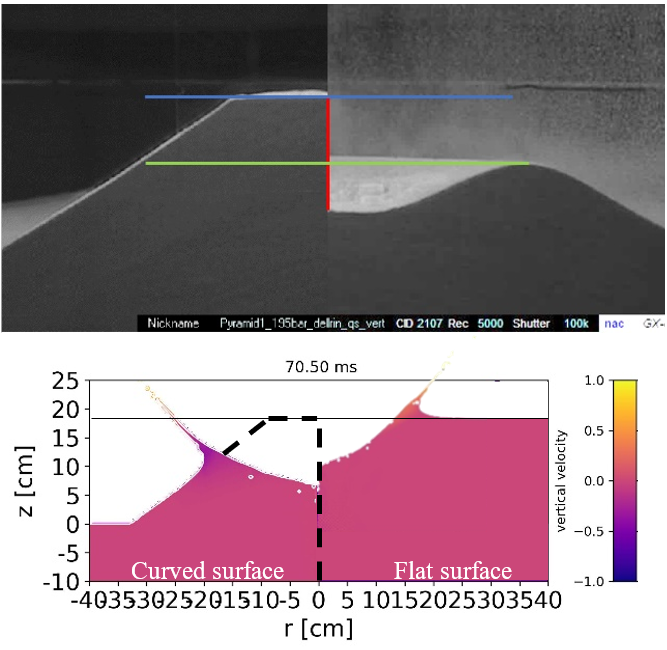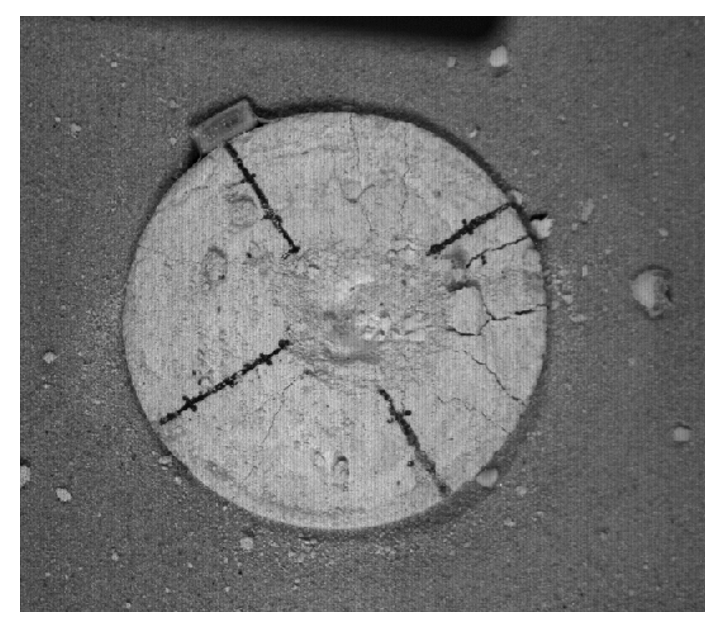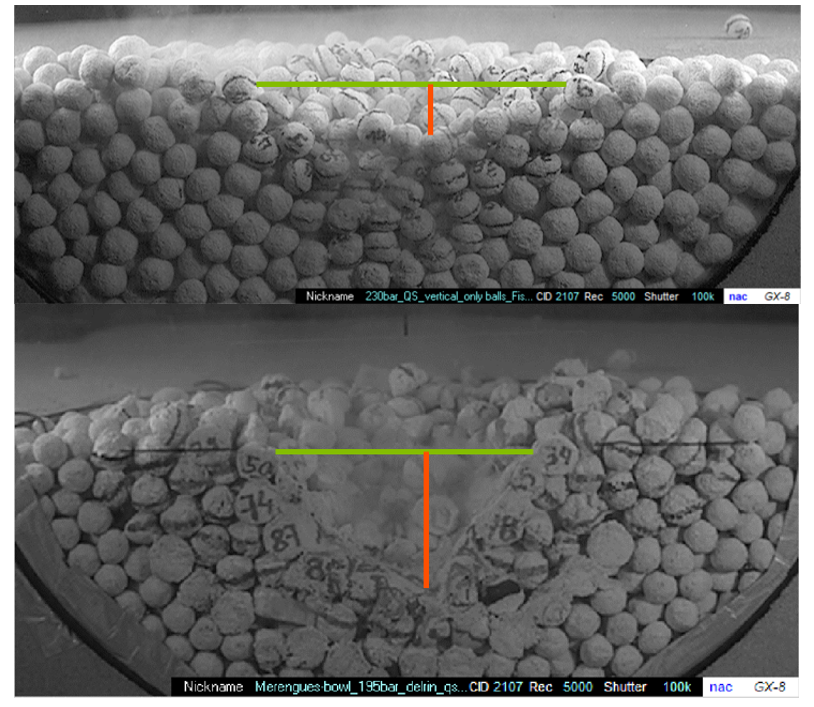Impact Experiments and Model Validation in the frame of the Hera mission
- 1Museum für Naturkunde - Leibniz Institute for Evolution and Biodiversity Science, Berlin, Germany (robert.luther@mfn.berlin)
- 2CAB INTA-CSIC, Spain
- 3Universidad de Alicante, Spain
- 4Universität Bern, Switzerland
- 5Freie Universität Berlin, Germany
1. Introduction
The launch of the Hera mission is scheduled for October 2024 [1]. The target of the mission is the binary Didymos system, especially the secondary Dimorphos, which was impacted by the DART mission on 27th September 2022 at 01:15 am (CEST) [2]. The mission shall provide a detailed characterisation of the two bodies and discover what happened to Dimorphos after the impact. To better understand the cratering process, numerical impact simulations have been conducted to analyse the effects of various target properties, (e.g. as strength and porosity), interior structures and exterior boulders, on the outcome of the cratering event [e.g. 3-5]. Nevertheless, these shock physics codes need to be validated against laboratory experiments [e.g. 6-8]. In this study, we explore the effects of curvature of the asteroid strength (cohesion, crush resistance), porosity, and density of boulders on the cratering process in laboratory experiments at the EPIC facility in CAB, and we use these experiments to validate numerical codes.
2. Method
Impact experiments are performed using the EPIC accelerator, which is a 20 mm calibre compressed N2 (300 bar) cannon that launches projectiles at velocities up to ≈420 m/s. The experiments, half- or quarter-space, can be recorded with two high-speed cameras. In the experiments presented here we have kept the impact velocity constant at approximately 380 m/s and used 20 mm spherical delrin projectiles. We used motion tracking sensors with a 100 Hz sampling rate to measure the seismic signal that is generated by the impact. For the first experiment, approximating the surface curvature of an asteroid, we used a target of quartz sand piled in the shape of a half-frustum of ~17 cm height (quarter-space). For the target properties-studies we used two unconsolidated targets of projectile-sized boulders of different strength (cohesion, crush resistance) in quarter-space configuration. The weaker boulder material is made from a blend of sand and gypsum with a lower crush-strength than the porous ceramic boulders in the other experiment. The material of the sand/gypsum boulders was also tested in a homogeneous cylinder impact setup (half-space).
To simulate these experiments, we use the iSALE shock physics code [9-11], applying different strength models and the ε-α-porosity compaction model: For sand parameters, we refer to [6].
3. Results
The crater in the frustum target (Figure 1, top) reaches a transient stage after ~85 ms. The crater is larger than a crater in a flat sand target (Figure 1, bottom). First models of the frustum experiment yield a similar crater diameter (+16%).

Figure 1: Frustum. Top: Images of the original target (left half) and the final crater (right half). Colours denote: Blue – 26.7 cm crater width at pre-impact surface level when the maximum depth (8.2 cm, red) is reached (49 ms). Green – 27.3 cm crater width of final crater. Bottom: Simulation of frustum (left) and flat sand target (right) after 70.5 ms. The dashed line indicates the shape of the frustum.
The crater in a cohesive homogeneous target of low strength (Figure 2) resembles typical craters in competent rock with fractures and spall pieces.

Figure 2: Homogeneous weak (but cohesive) material buried in sand. The cylindric material is 20 cm in diameter and 20 cm in depth. The crater is ~7.1 ± 0.5 cm in diameter.
The experiments with targets made of boulders of two different strengths produce craters of different characteristics (Figure 3). While the diameters are similar, the depth of the crater with weaker boulders is much deeper than in the case of stronger boulders, yielding a depth-diameter ratio of ~0.56 instead of ~0.19. In both cases, impact generated dust is injected into the pore space in the target. In the weak target, more boulders are crushed, and fragments are ejected. In the stronger case, ejection is mostly suppressed.

Figure 3: Craters in unconsolidated targets of strong (top) and weak (bottom) cohesive, projectile-size boulders. The diameters (green) are 20 cm & 17.7 cm, respectively, and the depth (orange) is 3.8 cm & 9.9 cm.
4. Conclusion and Discussion
Our experiments serve as validation scenarios for shock physics codes. First simulations can reproduce the resulting crater shape and diameter (Figure 1), but further modelling is ongoing.
The experiments show that surface curvature plays an important role for the cratering event if a large fraction of the crater growths beyond the flat surface. In our case, the flat top diameter of the frustum is about the size of the crater radius in a flat target, i.e. about half of the cratering is ongoing beyond the flat surface. In contrast to a flat target, the release of the pressure and the resulting pressure gradients are not vertical (i.e. there is a horizontal component influencing material movement), and a larger lateral growth of the crater occurs.
The experiments with targets of homogeneous projectile-sized particles (“boulders”) show some transition of the cratering regime from typical crater shapes to deep craters and funnels [cf. 12, 13]. Besides impact velocity or the projectile-target density ratio, the transition seems to depend on the strength and crushing behaviour of the target.
Acknowledgements
We gratefully acknowledge the developers of iSALE (www.isale-code.de). The work by J.O. and S.D.R. was supported by grant PID2021-125883NB-C22 by the Spanish Ministry of Science and Innovation/State Agency of Research MCIN/AEI/ 10.13039/501100011033 and by “ERDF A way of making Europe”. R.L., J.O., I.H. S.D.R., M.J., and K.W. were supported by the Spanish Research Council (CSIC) support for international cooperation: I-LINK project ILINK22061.
References
[1] Michel P. et al., PlanSciJour,3,160,2022.
[2] Daly R. T. et al., Nature,616,443-447,2023.
[3] Stickle A. M. et al., PlanSciJour,3,248,2022.
[4] Raducan S. D. et al., Nature Astronomy,8,445-455,2024.
[5] DeCoster M. E. et al., PlanSciJour,5,21,2024.
[6] Ormö J. et al., M&PS, 50(12),2067-2086,2015.
[7] Luther R. et al., PlanSciJour,3,227,2022.
[8] Ormö J. et al., EPSL,594,117713,2022.
[9] Amsden A. et al., LANL,LA-8095,101,1980.
[10] Wünnemann, K. et al.,Icarus,180,514-527, 2006.
[11] Collins, G. S. et al., Int.Journ.Imp.Eng.38,434-439,2011.
[12] Kadono T., PSS,47,305-318,1999.
[13] Luther R. et al., M&PS,58(12),1832-1847, 2023.
How to cite: Luther, R., Ormö, J., Herreros, I., Benavidez, P., Raducan, S. D., Jutzi, M., Baldauf, S., and Wünnemann, K.: Impact Experiments and Model Validation in the frame of the Hera mission , Europlanet Science Congress 2024, Berlin, Germany, 8–13 Sep 2024, EPSC2024-194, https://doi.org/10.5194/epsc2024-194, 2024.